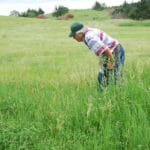Meadowlark and Bobolink Song Herald Cherokee Farmer’s Success
CHEROKEE, IOWA – This past weekend, as part of a Practical Farmers of Iowa Field Day, 15 farmers and friends of farmers spent their Saturday afternoon roaming the pastures of Cherokee resident Nathan Anderson to learn more about rotational grazing. Not on the guest list but there anyway as if to say, “Hey, it’s working!” were bobolinks and meadowlarks as well as a wide variety of native warm season grasses that hadn’t been present the year before.
Nathan Anderson, with the help of dad Randy Anderson and fiance Sarah Joachim, has been restoring a perennial pasture on which they graze a cow-calf herd of eight cows with calves and five heifers. Nathan has taken this pasture, which was once continuously grazed, and implemented a rotational grazing system to try to improve the health of the land and the animals being raised there.
According to Anderson, increased agriculture production since the 1940s has decreased native grass and bird habitat, decreasing their prevalence across the plains of Iowa. One of the high points of the day for Anderson was being able to show others the difference that rotational grazing has made on his pasture in just a little over a year’s time. “It’s amazing how resilient the environment is and what Nathan has accomplished with proper land management,” explains participant Steve Reinart. “By giving pastures short rest periods, we can bring the land back to a healthier state.”
PFI Grazing Specialist Kevin Dietzel underscores the significance of Reinart’s observation, “Nathan didn’t have to purchase and plant any seed or bring in birds. Nature simply reestablished itself when provided with the right environmental conditions.”
Although there are many different types of rotational grazing systems, keeping the animals off the land for brief resting periods is at the heart of all of them. Rather than let the animals consume the plant life of the pasture when and wherever they choose, Nathan uses fencing to create paddocks and employs a system in which he moves the cattle from paddock to paddock at least once every week, often every three to five days. This provides each paddock with 40 days of rest and allows the plant life sufficient time to regrow and for wildlife such as the bobolink to move in.
The length of rotation is based on available forage and paddock size. According to Anderson, the goal is to move the cattle before plant height dips below four inches and hinders regrowth.
As part of a research project with Practical Farmers of Iowa, Nathan is measuring and recording forage diversity and productivity by counting the number and types of plants in his pasture. He is also analyzing soil samples to track changes in soil quality over time and monitoring calves’ rate-of-gain and cows’ body condition scores.
Rotational grazing has been around for several decades, according to Dietzel, but has not been widely adopted. The extra planning and labor required discourages some farmers from giving it a try. For Nathan he feels the payoffs are well-worth a little extra effort. “You can feed more animals per acre, produce more forage and you don’t have to invest in fertilizers and herbicides,” he says.
Anderson adds that animal waste helps to fertilize the pasture and the rotation ensures the waste is evenly distributed. Even the hoof action of the cattle improves the soil. By trampling the grasses into the soil, the cattle help to break down the plants. Among the by products are nutrients such as nitrogen and carbon, which in turn, feed microbial life in the soil and build organic matter.
Nathan Anderson’s field day is one of more than 30 being held by Practical Farmers of Iowa in 2011. Most field days are free, and everybody is welcome to all of them. For a copy of the 2011 Field Day Guide, you can call the PFI office at 515.232.5661 or download a printable PDF.
Practical Farmers of Iowa recognizes the following sustaining sponsors: Albert Lea Seedhouse, American Natural Soy, Iowa Farmers Union, ISU Extension, Midwest Organic and Sustainable Education Service (MOSES), Seed Savers, USDA Sustainable Agriculture Research and Education (SARE), and the Leopold Center for Sustainable Agriculture, in addition to the following major sponsors: Iowa Forage and Grassland Council, Midwest Organic Services Association (MOSA), CROPP Cooperative of Organic Valley/Organic Prairie Family of Farms and Iowa State University Wallace Chair for Sustainable Agriculture.
Dan Looker, of Successful Farming magazine, also posted an article about this field day, which can be viewed here:
<http://www.agriculture.com/crops/other-crops/return-of-native-grasses_152-ar17288>
Supported by the Beginning Farmer and Rancher Development Program of the National Institute of Food and Agriculture, USDA, Grant # 2010-49400-21843






